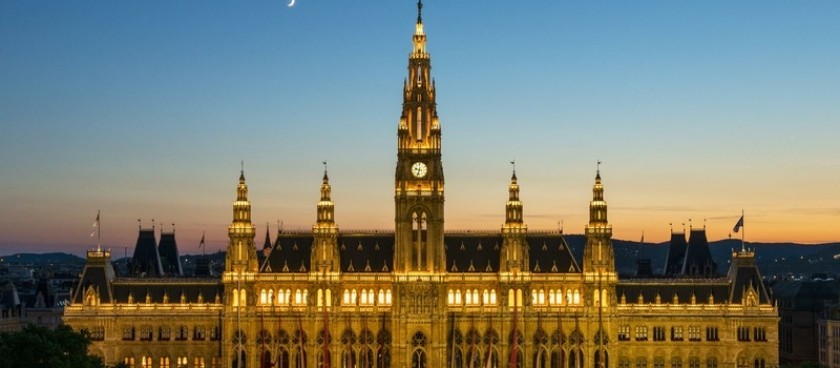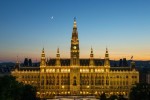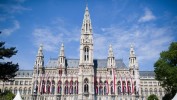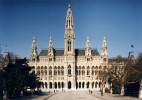- #AT05
- Friedrich-Schmidt-Platz 1, 1010 Wien, Austria
- +43152550
- Working hours*:
Monday - Saturday
8:00 - 18:00
Sunday - closed - * - opening and closing times as well as entrance prices, are subject to alterations without notice. Visitors are advised to check before visiting.
- 0.0000000, 0.0000000 Copy to clipboard Copy
History
By the mid 19th century, the offices in the old Vienna town hall, dedicated by the Austrian duke Frederick the Fair in 1316 and rebuilt by the Baroque architect Johann Bernhard Fischer von Erlach around 1700, had become too small. When the lavish Ringstraße was laid out in the 1860s, a competition to build a new city hall was initiated, won by the German architect Friedrich Schmidt.
Mayor Cajetan Felder urged for the location on the boulevard where simultaneously numerous representative buildings were erected, such as the Vienna State Opera, the Austrian Parliament Building, the main building of the Vienna University, or the Burgtheater. Construction costs amounted to a total of about 14 million gulden, borne by both the City of Vienna and the Imperial-Royal (k.k.) government after lengthy debate.
Architecture
The design of the richly adorned facade is modelled on the Gothic architecture of Flemish and Brabant secular buildings like the Brussels Town Hall. It features five towers including the central tower with a height of 98 m (322 ft). On 21 October 1882, the Rathausmann statue was installed on the top, which soon became one of the symbols of Vienna. The structure itself, spread over an area of 19,592 m2 (210,890 sq ft), is arranged around seven inner-courtyards, more along Baroque lines. A total space of about 113,000 m2 (1,220,000 sq ft) is spread over six floors and two basements with 1,575 rooms. It is largely built with bricks decorated with limestone, mainly from the Leitha Mountains, and ashlar masonry.
The Rathaus also accommodates the historic 'Wiener Rathauskeller' restaurant. The traditional restaurant consists of several baroque halls, offering small traditional Viennese delicacies to grand gala buffets.
Facing the city hall is the large Rathauspark.
The Vienna City Hall has the following structure from top to bottom:
- Main Tower (Rathausmann)
- Attic Storey
- 2nd Floor
- 1st Floor
- Half-Floor
- Ground Floor
- 1st Basement
- 2nd Basement
- Main Tower
1st Floor
The ballroom can be found on the first floor at the front of the hall, with views of the ring road, Burgtheater, and inner city. The 1st floor ballroom is 71 meters long and spans a width of 20 meters. The ballroom runs adjacent to the banqueting hall, also adjoining with the north buffet and armorial hall.
The Municipal Council Meeting Room and Municipal Senate Meeting Room are both also part of the first floor.
Ground Floor
There are numerous entry points into the Vienna City Hall via the ground floor. There are entrances to the north, south, and west.
The Volkshalle, or "People's Hall", is located on the ground floor, right below the first floor ballroom. The Volkshalle is used nowadays to host events.
Additionally, since 1927, the town hall guard, a special unit of the Viennese professional fire brigade, has resided in the ground floor of the town hall for security. Their duties include standard fire response duties and disaster control.
1st Basement
The first basement, also called the Vienna City Hall cellar, was first opened on 12 February, 1899. The artistic design was overseen by Josef Urban, and the historical murals by Heinrich Lefler. The first basement contains numerous rooms including the Knights' Hall, the Green Hall, and the Grinzinger Keller.
There were extensive renovations performed in 1925, 1952, and 2005, where historical murals and woodwork were fully refurbished.
Renovation work
On September 27, 2012 renovation work started on what is expected to be a 35 million euro project to renovate the building by the year 2023 when the work – expected to take place in 11 stages and affecting 40,000 m² – will be complete. Recently finished renovations (2000) include the grand re-opening of the neo-baroque Salon Ziehrer and the redesigned Lanner-Lehar Hall with wall and ceiling murals by German Trompe-l'œil artist Rainer Maria Latzke.



